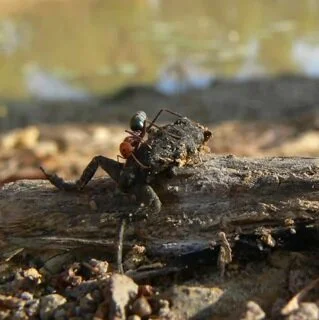Populations of the cane toad, an introduced species in Australia, have expanded rapidly since sugar farmers brought them to the continent 75 years ago to control pests. Today they are a pest in need of control.
With the use of cat food as bait, scientists at the University of Sydney succeeded in showing that native meat ants can be lethally effective assistants in the efforts to control the spread of cane toads.
The scientists followed ant-toad interactions on the Adelaide River floodplain 60km east of Darwin, Northern Territory, in the Australian wet-dry tropics during its dry season. Ant densities and toad mortalities increased more than fourfold with the addition of cat food baits.
The research demonstrated that the ants can be utilized with low risk of collateral damage to native wildlife. The approach is also logistically feasible, low technology and inexpensive.
Meats ants grappling with cane toad.
The team of scientists observed the effect of native meat ants on cane toad metamorphs (the first stage of the toad's terrestrial development) near bodies of water, and explored the cane toad's vulnerability to the native predator as a potential means of controlling cane toad numbers. When cat food was introduced as bait, ant numbers grew and cane toad numbers declined more quickly. After eating the cat food, the meat ants went on to devour nearby toads. When confronted by meat ants, 98% of the young toads were attacked within two minutes and 50% of those attacks were immediately fatal. Of those that escaped, 88% died within 24 hours.
The end result is that higher ant densities kill more toads, and kill toads of a wider range of body sizes. The cat food strategy is expected to form part of a multi-pronged attack on cane toads in Australia.
source: University of Sydney


